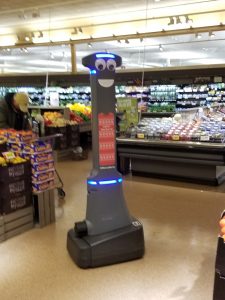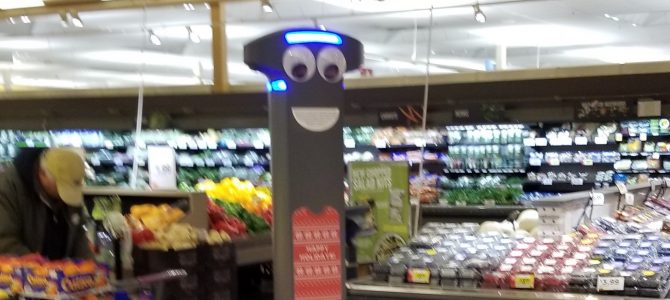While this article’s title may sounds dystopian, it’s the reality in the aisles of Stop & Shop, where I set out to buy dinner tonight in southern Rhode Island.

Beep. Boop. While on the hunt for green beans, a tall robot equipped with cameras, LIDAR sensors, stuck on googley eyes and a nametag “Marty” rounded the fruit display and accosted me. See photographic evidence. Initially, I thought it was a Knightscope security robot, set to spy on customers and follow around potential shoplifters. One had to get closer than comfortable to read the explanatory signage. Apparently, this creation of Kentucky based Badger Technologies, has a mission of seeking out missing price tags, out of stock items and jars of mayo dropped by careless customers. According to their marketing, this will enable stores to gain insight, lower operational costs and raise revenue. Oh, and it’s backed by a team in the Philippines that video link in to supplement the radar. So, effectively, “Cleanup on aisle 6!” has been outsourced to Manila. If we add remotely deployed Roombas, it’s game over for the mop and bucket crew. I am not convinced that this represents retail progress.
Real progress is finding ways to better serve customers and, thus, increase revenues, not just ways to reduce costs. While the former creates value, the latter can only ever capture value in the long term. (Though it can create short-term investor value.) Some companies have learned this with great success. Case in point, Delta Airlines, which has steadily been increasing inflight service and reaping the profitable rewards. Other large companies lumber along, or worse, randomly implement technology without a firm grounding in customer discovery.

Now to the subject of beans. With all its sensors, the robot could not see me commiserating with a fellow customer over a display of bagged green beans. We both wanted a bin of loose beans, so that we could select just enough for dinner, not a family sized bag. Both of us lived alone. The deli counter was also sadly lacking of prepared foods and the tortellini salad that I did buy was old. We agreed that, in general, shopping at Stop & Shop was painful, since it did not cater to our demographic.

The cluelessness continued at the checkout where the system beeped and booped relentlessly, fussing about the bagging area, until I cussed it out and hit it which, amazingly, caused a receipt to pop out accompanied by two coupons: one for People magazine and the other for a chewy snacks, see photo. Tonight I bought salad + steak + pasta + milk. Any sort of marginally intelligent (machine learning, AI, insert buzzword) system would have profiled me as a single guy and guessed that these were not likely to be a hit.
Both of us departed thoroughly unsatisfied and I am not going to return.
Proper customer discovery on the part of Stop & Shop would tell them that US family demographics are changing: The 2017 US census indicated that 28.1% of people lived alone, up from 17.1% in 1970. There is also a decrease in family size and an increase childless couples and the cost of raising children has steadily increased. Altogether, I fit in a demographic with disposable income, that shops smaller and more often, values efficiency and expects technology to just work.
Reading Stop & Shop’s corporate history since 1914 shows scant technical sophistication, with “computerized” stores in 1986, hand held SCAN IT! scanners in 2000 (recently relaunched, but only in a form that works with carts), a mobile phone app (with more negative than positive reviews) and the launch of a Facebook page. Yey. Robots and poor automation won’t help large supermarkets that persist in antiquated mindsets compete with the likes of Whole Foods + Amazon, which offer just what one needs fast, or smaller, more nimble, groceries. Retail is not dead, it just needs to adapt and this adaptation must be based in solid customer discovery including literature reviews, focus groups and good old customer observations. How about empowering and incentivizing every associate to gather customer insights? Collect these insights and see what percolates to the top. Conduct highly targeted design exercises with outsiders as facilitators. Develop prototypes, deploy and collect data. These are proven methods. While revenues are not reported, with estimates of many billions of dollars, this is a company with the resources to do much better than creepy googley eyed robots meandering around silently.

